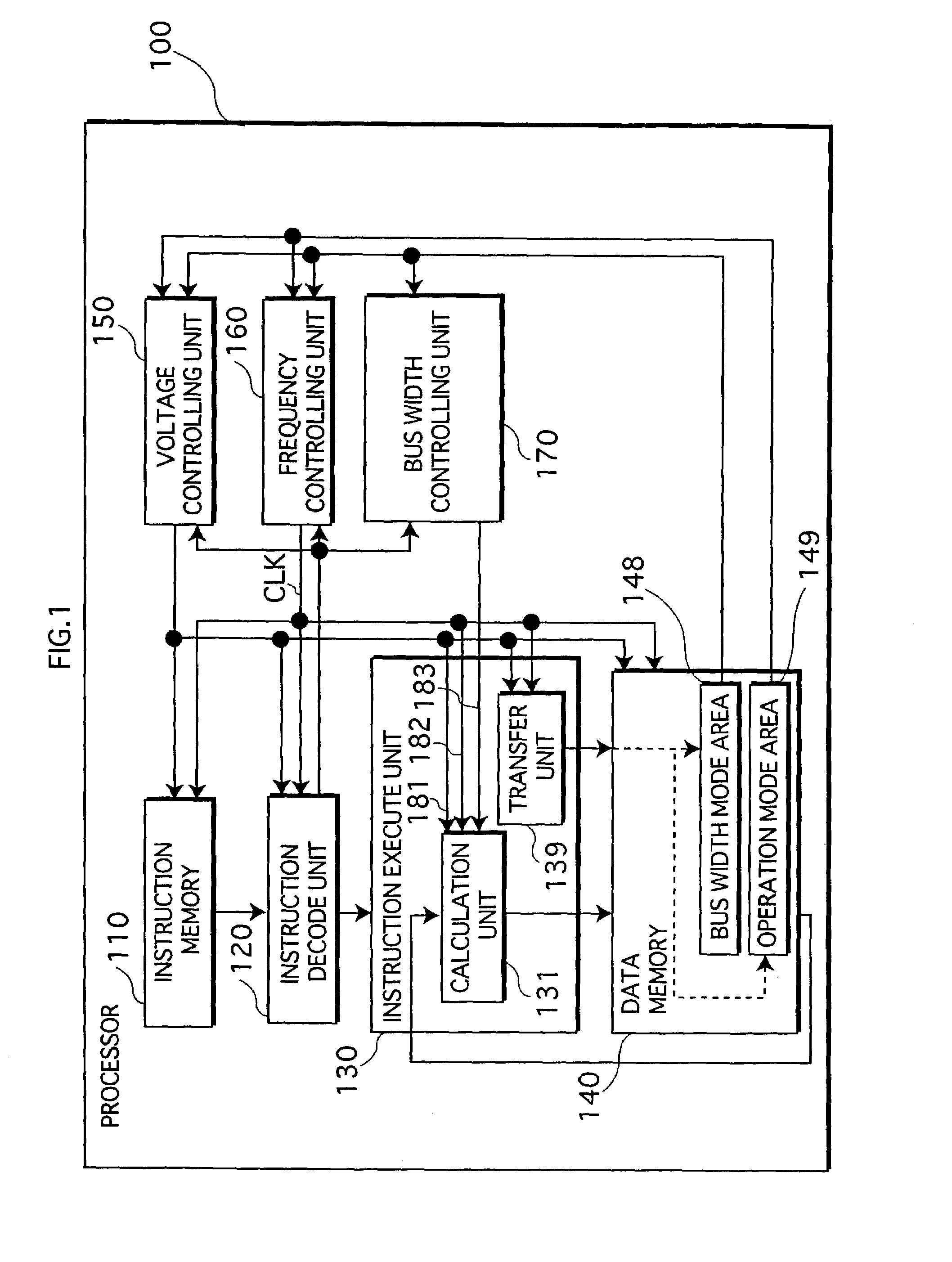Microprocessor
- Summary
- Abstract
- Description
- Claims
- Application Information
AI Technical Summary
Benefits of technology
Problems solved by technology
Method used
Image
Examples
first embodiment
1. First Embodiment
[0053]The following describes the processor 100 in the first embodiment of the present invention, with reference to FIGS. 1 through 5.
1-1. General Structure
[0054]FIG. 1 is a functional block diagram of the processor 100 in the first embodiment of the present invention.
[0055]The processor 100 is a processor that decodes instructions in a program stored in an external memory and executes processing specified by those instructions. The processor 100 is constructed with a CMOS (Complementary Metal Oxide Semiconductor) and includes the instruction memory 110, the instruction decode unit 120, the instruction execute unit 130, the data memory 140, the voltage controlling unit 150, the frequency controlling unit 160, and the bus width controlling unit 170, as shown in the functional block diagram in FIG. 1.
[0056]It should be noted here that the instruction memory 110 is a cache memory for storing instructions to be executed that are fetched from an external memory. The ex...
second embodiment
2. Second Embodiment
[0118]The following explains the processor 300 in the second embodiment, in which part of the processor 100 in the first embodiment is modified, with reference to FIGS. 6 and 7.
[0119]The processor 300 is different from the processor 100 in that the processor 300 changes the bus width mode individually for each instruction to be executed, depending on the number of bits in the data to be calculated under calculation instructions such as an add instruction in an application program, whereas the processor 100 was basically on an assumption that it changes the bus width mode for each application program to be executed.
[0120]FIG. 6 is a functional block diagram of the processor 300 in the second embodiment of the present invention. It should be noted that some of the components of the processor 300 which are virtually the same as the components of the processor 100 are indicated in FIG. 6 with same characters as in the FIG. 1, and detailed explanation of those same co...
third embodiment
3. Third Embodiment
[0135]The following explains a modification in which a special write control is performed for writing into a part of the data memory 140 a piece of 16-bit data (dest [15:0]) and a carry bit signal (carry) both outputted by the calculation unit 131 in the processor 100 in the first embodiment, with reference to FIG. 8.
[0136]FIG. 8 is a diagram to show a part of the data memory 140 that is capable of performing write control in the third embodiment.
[0137]The data storing areas 141a, 141b, and 141c are an area for 8 bits, 4 bits, and 4 bits respectively, and these three data storing areas together make a 16-bit register. Each of the data storing areas is independent, and is arranged so that only when it receives a write signal, it will store in a storage element the data on the buses, which is a result outputted by the calculation unit 131.
[0138]The write controlling unit 143 is a circuit that performs control for having the data outputted by the calculation unit 131...
PUM
 Login to View More
Login to View More Abstract
Description
Claims
Application Information
 Login to View More
Login to View More - R&D
- Intellectual Property
- Life Sciences
- Materials
- Tech Scout
- Unparalleled Data Quality
- Higher Quality Content
- 60% Fewer Hallucinations
Browse by: Latest US Patents, China's latest patents, Technical Efficacy Thesaurus, Application Domain, Technology Topic, Popular Technical Reports.
© 2025 PatSnap. All rights reserved.Legal|Privacy policy|Modern Slavery Act Transparency Statement|Sitemap|About US| Contact US: help@patsnap.com



